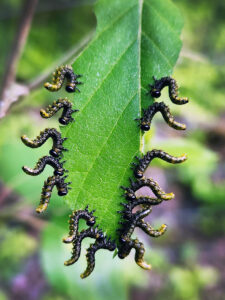
While feeding on a white birch leaf, dusky birch sawfly larvae raise into an S shape when a potential predator is noticed. / Photo Credit: Linda Williams, Wisconsin DNR
By Linda Williams, DNR Forest Health Specialist
Linda.Williams@wisconsin.gov or 920-360-0665
Dusky birch sawfly (Croesus latitarsus) is a native sawfly that feeds on white birch and occasionally river birch and yellow birch. Larvae feed in a group at the edges of birch leaves and abandon part of the midrib before moving on to another leaf.
Defoliation is typically light, with a few dozen leaves per tree being eaten. This defoliation is only problematic on young seedlings with few leaves. There may be two generations of larvae in a year.
Unless more than 50 percent of the leaves are consumed, no control is necessary. Handpicking the leaves that have larvae feeding on them and squishing the larvae or dropping them into a container of soapy water can help reduce populations on smaller trees.
If pesticides are needed, it’s important to know that the products based on the biological pesticide Bacillus thuringiensis var. kurstaki cannot be used because these are not caterpillars. They are sawfly larvae, so general insecticides will need to be used.
The larvae in the photo are employing a defensive strategy, raising up into an S shape to look larger and more threatening to potential predators.
